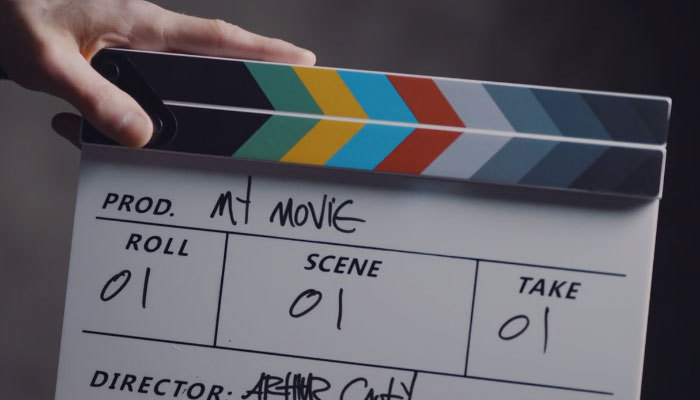Today we’re speaking with Chris Tellefsen, ACE about his ACE Eddie-nominated editing of The Menu. Chris has been a guest on Art of the Cut several times before for The Many Saints of Newark: A Soprano’s Story, also for A Quiet Place and Assassin’s Creed. He also worked on Joy, which was a previous Art of the Cut interview.
Chris was nominated for TWO ACE Eddie in 2000 - for Analyze This and Man on the Moon. He was nominated for an ACE Eddie and an Oscar for Moneyball. Another ACE Eddie nomination for Joy. And won an HPA Award for A Quiet Place.
In addition, he cut True Story, A Guide to Recognizing Your Saints, Kids, gummo, Capote, and The Village, among others
The opening scene - and the opening shot in the opening scene, in particular - has gone a little bit viral. Your star in the opening scene is Anya Taylor-Joy and the movie fades up on an extreme close-up shot of her smoking a cigarette, only it’s not her. It’s actually a stock footage shot of a woman smoking a cigarette. So what was the value of that opening shot and what was the discussion between you and the director to use that to start the film?Art of the Cut: with Chris Tellefsen about editing of The Menu
The opening of the movie was always a challenge. There were many setup scenes. There were three that we cut. On the boat, Lillian told the entire history of Chef Slowik, his rise, his fall, that he disappeared, and then she rediscovered him in a Korean taco truck, thus the taco that put him on the map. She also wrote a famous article about him that spawned Hawthorne, the restaurant that they're at, financed by tech billionaire Doug Varrick. It was just too much. There was also a miniature of the entire island and all the guests listening to Elsa talk about how this was to be an evening of surprises. That was just too leading. We found that the key to the start of the film was to keep up a sense of mystery concerning Chef Slowik. We needed to get through these things. There was an Adam McKay note. He said, “We really like the end with fire. We should start with fire. Do we have a close-up of her lighting up?” We didn't have a close-up for lighting up and Anya's a very busy woman. She was in Australia shooting, so that wasn't gonna happen. We dug very hard and found a stock shot that just was very tight and simple and it did the trick.
I love it. So the point was not that you needed the shot…It was parenthetical.
Bookended...It's very interesting that those scenes were dropped. It sounds like the scenes that you dropped were a little too leading.
The thing that's great about Ralph is he reads so clearly. He's such a great actor. You don't need all that setup.
And you get all that stuff later in the film.There weren't threads within what was lost that became problematic later. When Lillian talks about the taco that put him on the map, you didn't need the whole thing explained on the boat.
 Tell me about your assistant editor... he was helping set things up at the beginning of the interview.
Tell me about your assistant editor... he was helping set things up at the beginning of the interview.
That's Jordan. Jordan Farewell. My first assistant is David Rogow. My two second assistants are Courtney Marquard and Jordan Farwell. I have a great crew. I adore them. They're wonderful.
Tell me about the importance of being organized as an editor. I'm sure they help you, but you must do some organization too.They do it all. I depend on my crew, from day one, from the first day of shooting, I'm getting those scene bins ASAP, as soon as humanly possible. I like to do a knee-jerk cut of each scene, keeping up with the shooting as it is happening. If there's anything to flag up or any problems, it's helpful.
What are some of the things you ask them to do so that you are organized?On the project I'm on right now, "NYAD", there's tons of archival footage. At some point I might say, “This is getting confusing. You have to separate some of this out.” There are a lot of categories and it gets messy. I also request that script sync be done as scenes come in.
Can you talk about intercutting - like at places where the storylines diverge?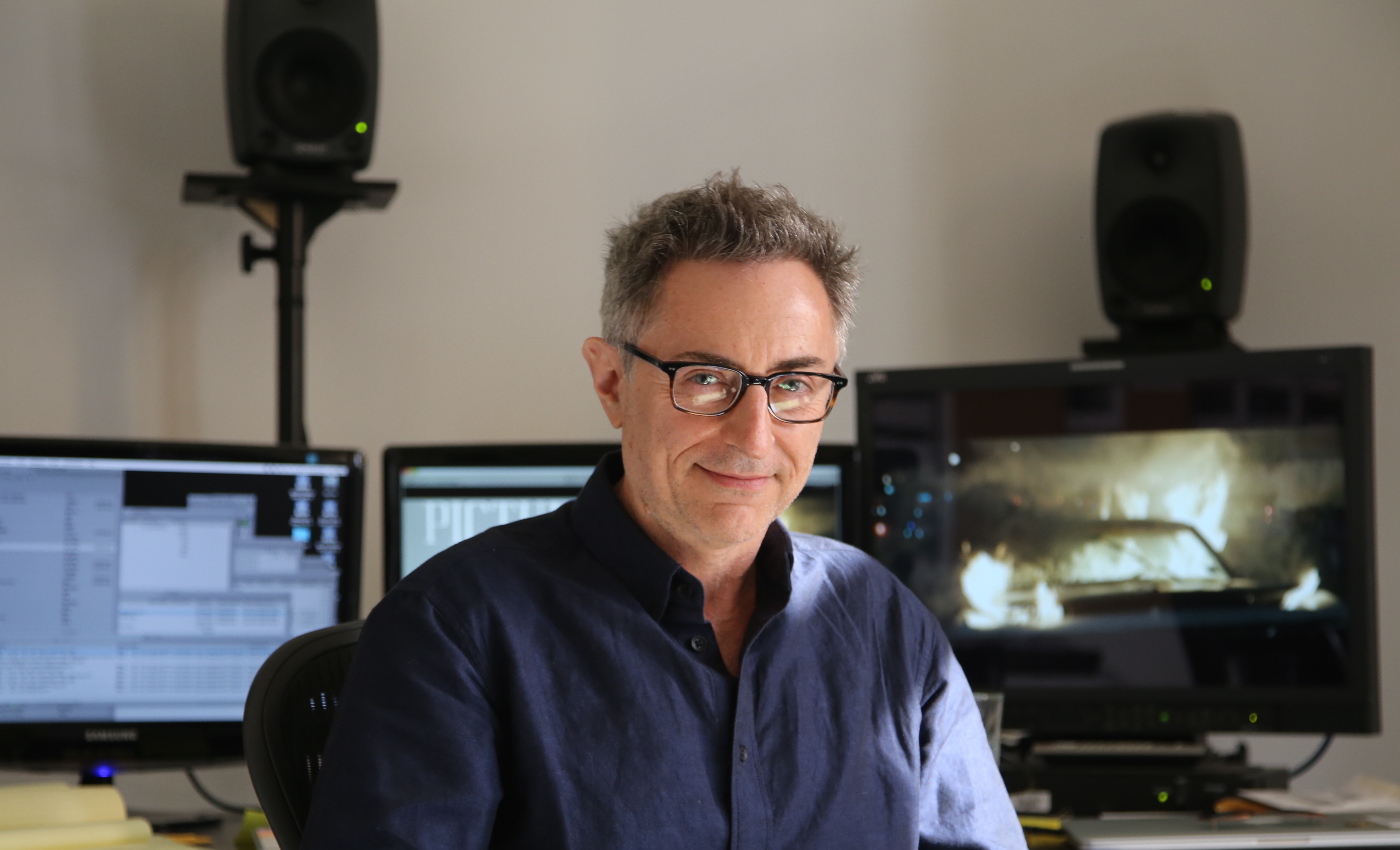
Chris Tellefsen, ACE
The structure of The Menu is the dinner, course by course. Each course is very specific. There couldn't be scene shuffling. There was a lot of work and change that happened within scenes, though shots were stolen from some courses to flesh out others.That's the beauty of your characters wearing one costume. A challenge was when the women are left to eat together and the men are given a chance to escape, getting the right rhythm and the right balance between the two.
Mark wanted it in an Altman-esque style so every single table and every actor was mic’d for every shot. There was a massive amount of improvisation. Just a lot of gold. Beautiful stuff, but you can't use everything. The first cut was 2 hours, 40 minutes. Some of it's just brilliant, but the task of this is finding the emphases and finding the balance between all of these characters.
There's an obvious hierarchy too. The main focus on the diners is, of course, going to be Margot and Tyler. Then, everyone else swirls around them. It was fun mining the humor, violence and tension, weaving in the controlling Chef and Elsa, the Maitre D' Chef is like a cult leader. He has this mesmerizing presence and the diners are there for a very specific experience. They're just open and ready to get their money’s worth. Then, it all devolves.
You mentioned Altman-esque filming. I’ve actually interviewed Altman himself. But what do you mean by Altman-esque?Overlapping dialogue. Every character is mic’d and in their own world at the same time. Then, it's a matter of emphasis, of where you're going to be, but there's still the constant presence of all that chatter. It's not like one thing at a time. It's many things going on, but you have to find where you want to land, especially through mixing. Where the levels are and what you're gonna catch and what you're gonna, sort of, just let fly to the side and BE an aside. Many fun lines went that way. Then...where to emphasize?
Emphases?I dunno.
I would also think, with the ad-libbing, the tonality is really important. You don't want it to go full-on Will Ferrell comedy.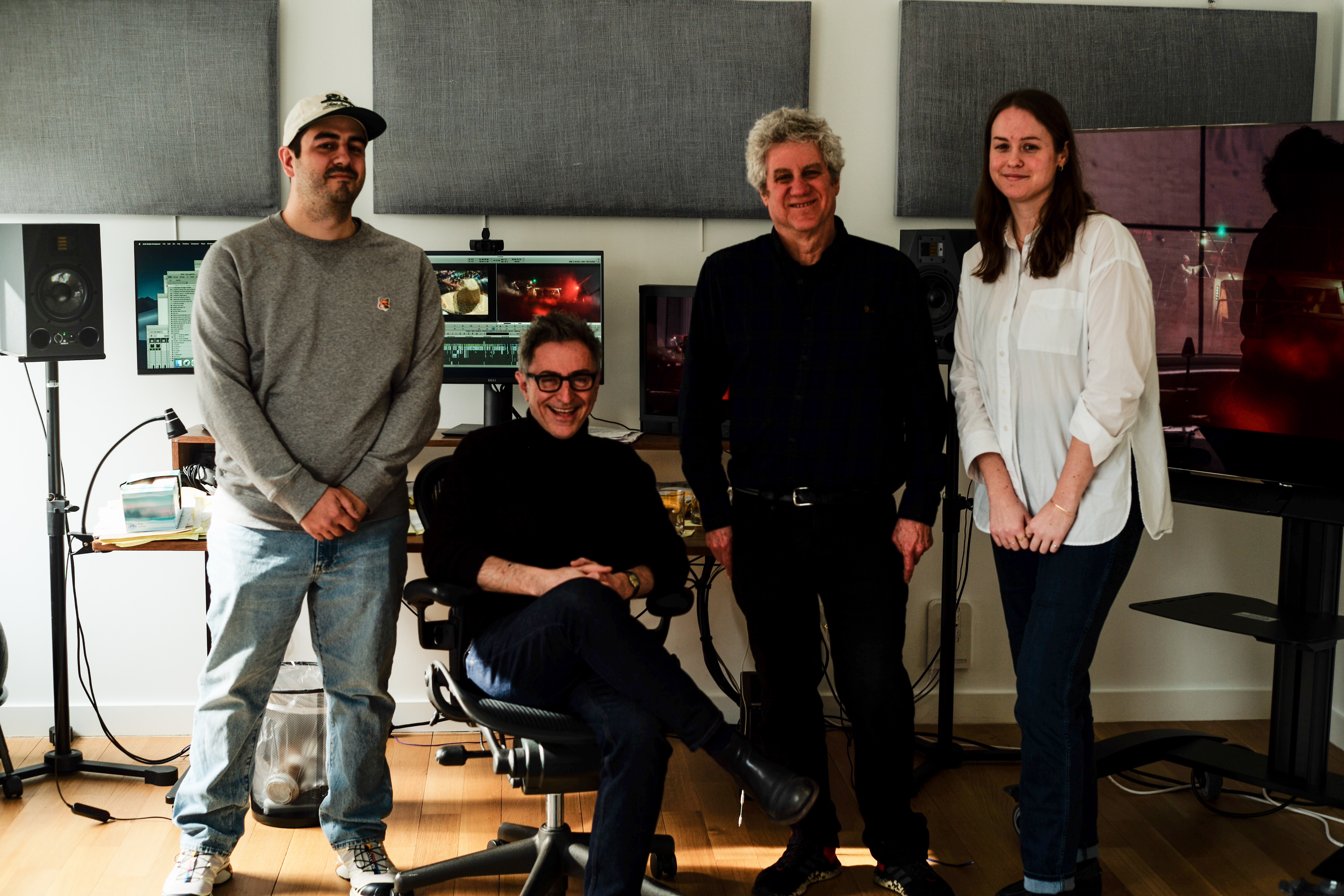
Post team Left to right: Jordan Farewell, David Rogow and Courtney Marquard
Oh, exactly. There were a lot of very wry and fun things. One thing that was really fun was when John Leguizamo and Amy Carrero lapsed into Spanish when they were arguing. That was great and you got the tone of their exchange and it didn't get in the way of others. There are all these levels. Then, the dead quiet of the elder couple who were just icy and —
Aloof. You mentioned when the men go off and the women are separated and how that intercutting was different, how you needed to massage that. Can you talk about that? ‘Cause I'm sure it wasn't the same as the script.Yes and no. There was more of the women. There was a whole thing where they got bread. It was kind of fun, but it sort of didn't work quite well enough. We just wanted to make the high points of it play and and not get too dispersed in order for the reveal that Katherine was the author of everyone's demise to hit hard. We were able to sharpen it with cuts to the men trying to escape, then, heighten the comedy of Paul hiding in the hen house. Especially since we're in these enclosed environments, the contrast helps in the back and forth.
We were in the middle of talking about the women and the men separated.Ted, Lillian's editor from the food magazine was in the henhouse. He was the sycophantic editor who would "yes" her to death, no matter what. If he had a thought, he'd immediately deffer to her. He's great. Paul Adelson is really a wonderful actor and played that role beautifully.
That brings up an interesting idea. You know these characters and the way they're supposed to be portrayed and how that then makes you edit them in comparison to somebody else.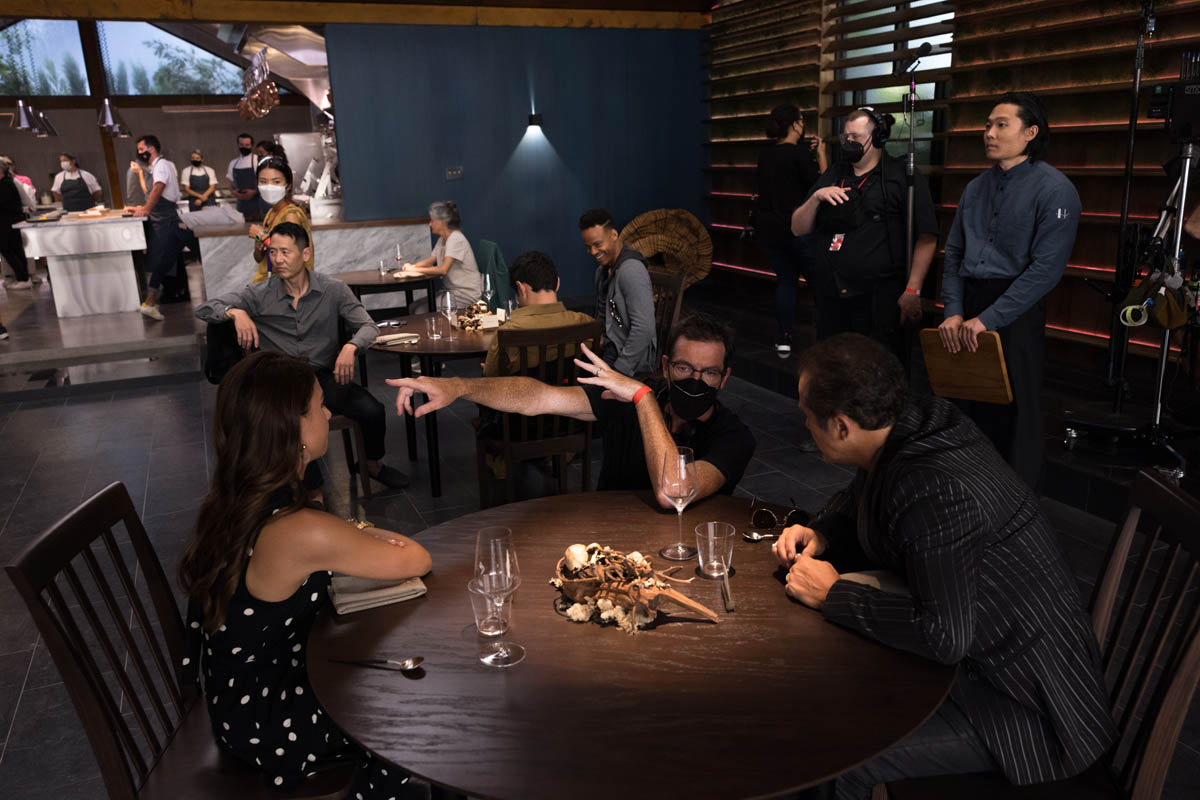
Sure. They have their very specific rhythm of speech and their interchange is different than the others too, their little glances at one another and their little eye raises. There's just tons of fun stuff to play with.
I would also think that even the conversations led you in the way they had to be edited, but I would also think, “Oh, I need some lightness here. This would be great to go to John Leguizamo.”Sure. There were a lot of situations where you could overlapp lines, like Judith Light drinking, overhearing that the wine was infused with "a sense of longing and regret". Peter Grosz, who played the sommelier was great.
Every description of the wine was better than the previous one.“A bit of barnyard funk” [laughs]. The height of fine dining is so ripe for satire. The fun is that people are getting it. I'm really enjoying that.
Was any of the sommelier stuff improvised?That was very scripted. The descriptions were marvelously strange, but then he would do little things here and there. His emphasis and his manner were always perfect, properly oblivious to any oddness or danger going on around him.
Can you remember any specific notes that you got on this film and then how you dealt with them? What is your attitude about notes?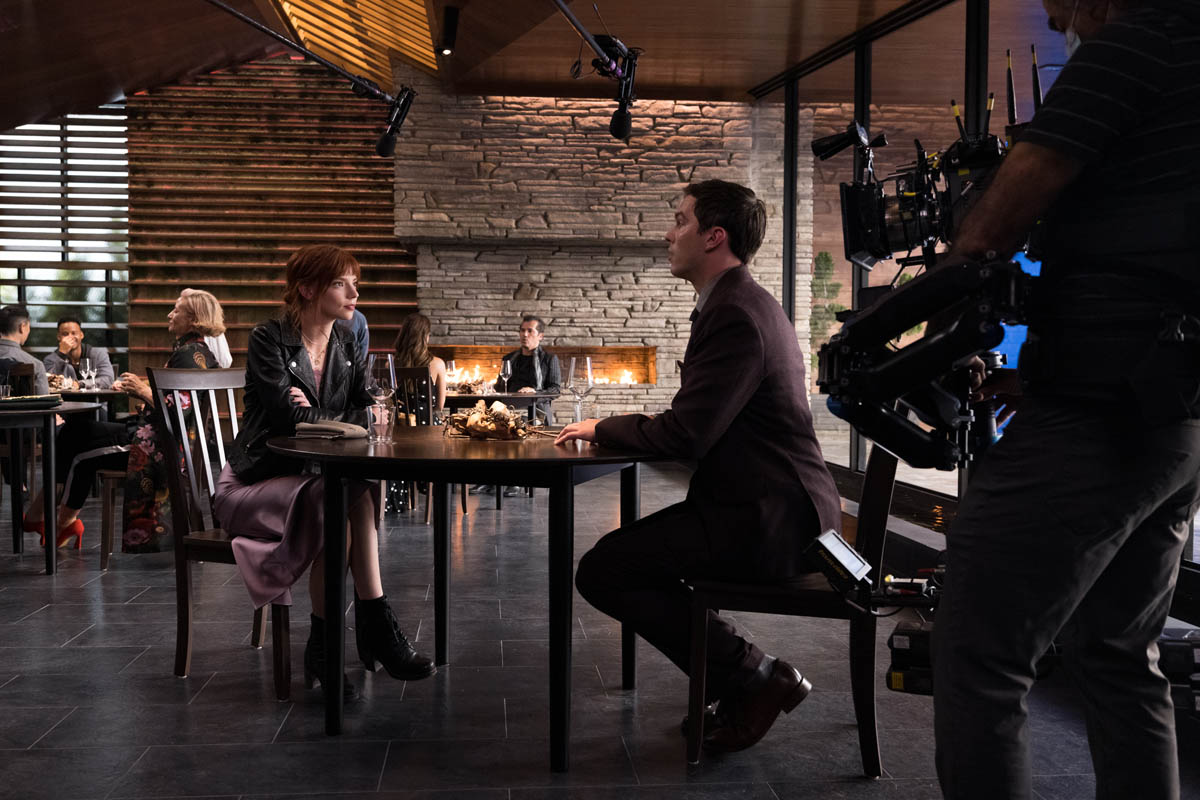
There was a producer's note to try dropping the whole business of going outside, Katherine's speech and the parallel of the men escaping and the women dining together. Mark and I were completely puzzled by the suggestion. We tried it as an exercise (and promptly dicarded it), but interpreted the note as needing to work three times as hard at making those scenes land better. As far as notes go, I will try anything. You never know how you might be surprised.
Everyone involved was very much on the same page of what the tone was. In the process of editing, it was mostly to mine that tone and play those very fine lines and find the way to bring it to its fullest strength. Most notes were very much like: “This isn't landing as hard as it should. Should we be emphasizing this more than that? How do we get The Mess to really play?” Theater vs reality. It was a constant working of all those aspects to get them all to work together and play and rise and fall and come to the proper end.
As far as scenes that were omitted, there was first, the explanation of Chef's history, Lillian's exposition on the boat. Then there was a whole disgarded introduction once on the island, Elsa bringing them around a table with a huge replica of the island and the restaurant and what they're going to be experiencing: this heightened, amazing dining experience. Then, this whole thing of walking through the gardens and talking about the farm-to-table aspect of it, which we kind of consolidated into the area where they just see the guy fishing for scallops.
There were a lot of things that were seeded in the script and we didn't need to seed that many things, like the whole thing of Lillian having rediscovered him. Also, it was set up that John Leguizamo had a peanut allergy and that one of the tech bros had a gluten allergy and Elsa kind of dismisses these things. there was a reference to Lillian having given a bad review to a restaurant, resulting in its closure.
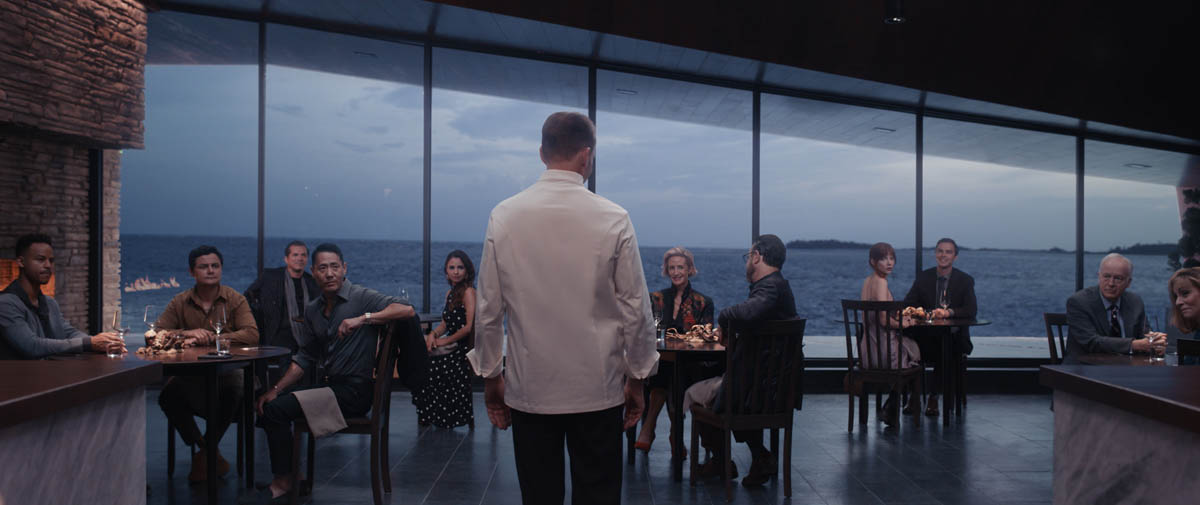
Later on, we cut a torture scene of Lillian being waterboarded with the broken emulsion and John Leguizamo being force-fed a very fancy peanut dessert. His face is blowing up and it's very extreme. It was just too much. I edited that a billion times and we worked it into a parallel with the fight in the kitchen and all these other things, but it never one hundred percent landed. It was just too much. It also took away from the heightened absurdity of the high angle of them becoming the dessert, the s'mores.
Beyond that, as far as things that were reworked and taken away, when Margot goes to the secret room, the way it originally worked in the script was she never actually saw the picture of him with a burger. You just saw her in an angle with the back of the frame and her light bulb moment, which was left to your imagination. Also removed was a coda at the end of the following day: Burnt-up restaurant, a crew wrapping up body bags, and then a zoom into the silver door. The silver door blows up and it moves in and it reveals the photograph of him as a young man, smiling and flipping a burger.
The whole thing of having to connect the dots at the end took away from the strength of her controlling him and the whole light bulb business with the burger. She did such a marvelous job of turning the tables and manipulating him, especially with the clap, shifting the power. Then, she basically works him into a frenzy of obsession, to make this perfect burger.
One other thing that was taken away for a very specific reason — worked on paper, but did not work on the screen — is she finds the radio and calls the Coast Guard in the secret room. She walks back into the main room, the replicated kitchen in Chef's Cottage. She sits down then you hear Chef’s voice on a loudspeaker.
They have this kind of cat-and-mouse talk back and forth. What it did was it made you just sit there saying, “Wait a minute. She just came out of that room. She was saying that and he's got a loudspeaker here. He knows that she did this.”
It just didn't play. It was much better to just have her just come back with the barrel, which was filled with God knows what that was gonna blow the place up.
You mentioned trying to get the scene with John Leguizamo eating the peanut allergy dessert to work and you said you tried to intercut it. I find that a lot of times if I need to make a scene work that's not working, I'll intercut it. That’ll save me.Oh yeah, sure. Paralleling is an important and standard divice. But It just didn't fit. It took us too far afield. It was enough to have The Movie Star interrogated and judged for being in a bad movie, that his assistant didn't need financial aid when she went to Brown and she was dying for that reason. That was one of our big laughs.
Chris, I wanna talk about the value of reaction shots. There’s a great scene to see this, so let’s watch this clip from when Chef welcomes everyone to his restaurant, Hawthorne.First off, you want Margot to be startled and that plays... that works. Then, it's a matter of the cult-like aspect, of how he has everything set up and how these people are coming and paying $1,250 to have this experience. They're hanging on his every word.
Also, the whole fanboy, sycophant aspect of Tyler. You wanna make sure that he’s really absorbing this. John Leguizamo asked, “Is it real?” when he says, “Don't eat.”
They’re very specific. Their reactions are to emphasize all of the things that he's saying, like, “Look around you, feel, breathe” and “Don't eat, but savor.” It's all very mesmerizing. Then, when he talks about “We are not important, we'll pass on, but all of the environment around us, the Earth, will stay.” Reed Birney's reaction to that is priceless.
It's like a guided meditation in a way and they're just absorbing it and feeling it. Then, Tyler is in tears and she’s incredulous that he’s in tears, so it's a build. I tried to build it to its best effect.
When you're trying to mine the performances for a scene like that, how do you watch dailies?I watch them as they come in. I try to replicate the experience of watching dailies on film. Back in the day, I used to sit in a theater, usually with the director and the crew, and watched each and every shot, thinking, absorbing, making notes on, especially, the specifics of performance, things that popped, things that came forward, that were memorable. That's the way I still watch dailies, but I do it alone.
I never experienced watching dailies in a screening room. I'm assuming you're saying that they were almost always — or whenever you watched them — they were shown in filmed order.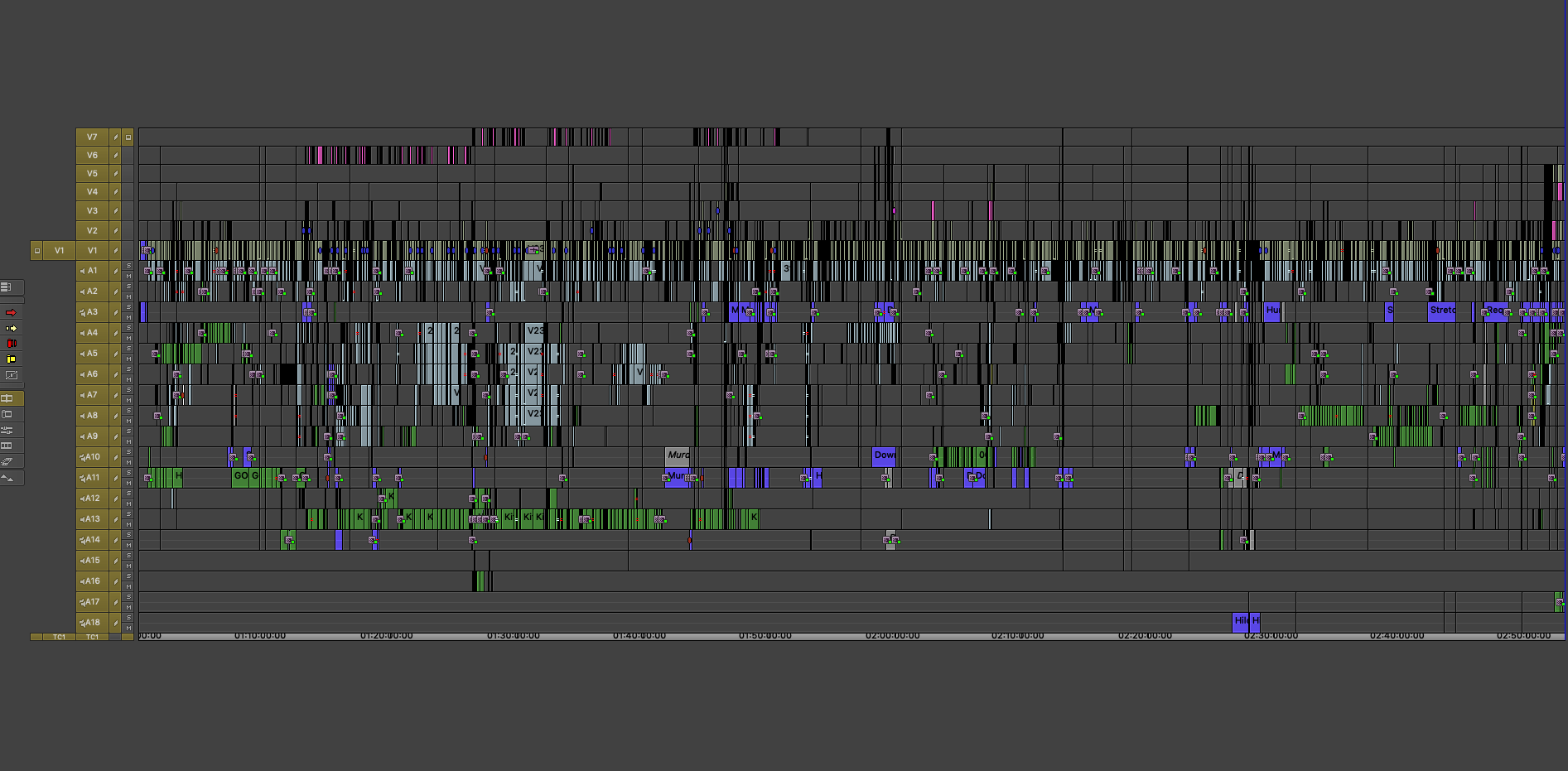
Timeline screenshot of the Avid timeline from "The Menu"
Yeah. Like the end of the day, it would be “the day before's” dailies because of processing. If you're on set or, let's say, they're shooting in the city and you're working there, you meet at the theater and you sit and watch it. On The Village, there was a mobile unit that was a screening room on the set.
Got it. You were nominated for an Oscar for Moneyball and you've been nominated for an ACE Eddie for The Menu. You've got a bunch of other nominations. When you are judging your peers for Oscar or ACE consideration, what are you thinking about?I'm thinking about how the film affects me. I'm thinking about what my experience of it was. Was I emotionally effected? Did I enjoy and respond to the construction of the film, the rhythm of the pace, the intentionallity and sensitivity to the material and the performances? That's what it's all about. I notice the seamlessness or the aggression of the editing, depending on the tone it sets. I notice that aspect of it and that's the driving force of what I think makes a great film.
I completely understand that idea. I think the last time we spoke, we talked about the fact that you were an assistant editor on The Color of Money and had just transitioned to being an editor in the 1990s on Metropolitan. Can you talk about the difference between your time cutting on film and when you made the jump to digital?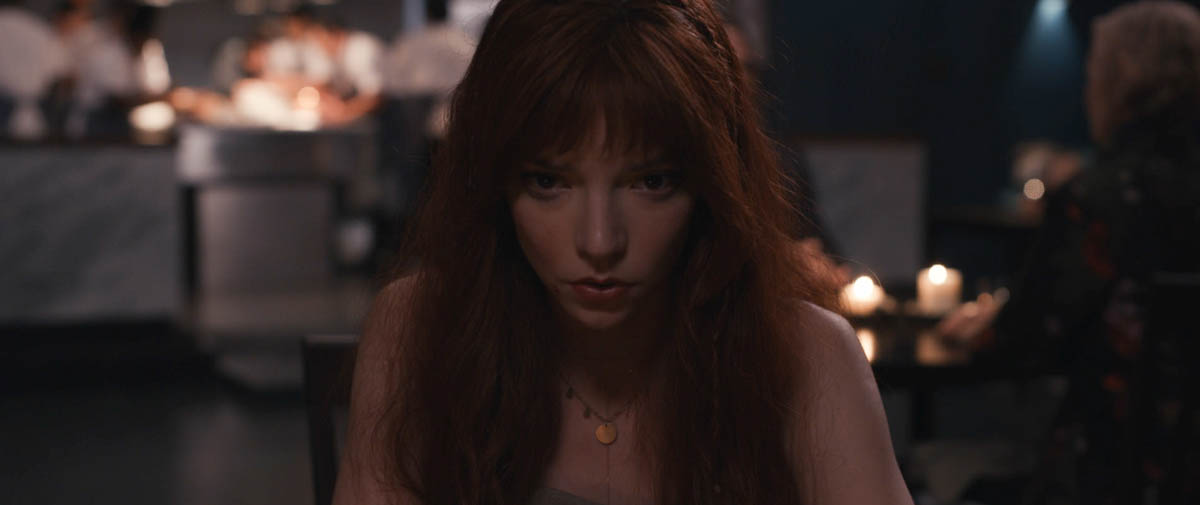
Sure. I cut my first seven movies on film, some of which were Metropolitan, Jumpin’ at the Boneyard, Barcelona, Darkness in Tallinn, and Blue In the Face, which was an offshoot of the film Smoke. I also did a pass on Smoke, but that was as an additional editor. Maysie Hoy was the main editor on that.
Kids was my last film cut. Then, Flirting with Disaster was my first digital job. I learned Avid to do that and it was very user-friendly. I really enjoyed the fluidity of it. The nonlinear aspect was great, but I loved cutting on film. If that's all there was, I'd still be doing it. I was fast with that blade in front of me.
Then, actually, directly after Flirting with Disaster, I did The People vs. Larry Flynt with Miloš Forman. He had a very specific demand. He hadn't made a film in seven years and he said, “I know it has to be digital, but I have to be able to have three cameras linking, like a Kem flatbed, where you can have three heads for multiple camera setups.”
I had to do some research and the only thing that was workable for that was something called Heavyworks, which was an offshoot of Lightworks. It was user-friendly, but it was cumbersome for assistants. It was Dos-based and it was a nightmare for them, unfortunately. The image wasn't as good as Avid either.
On all those films that you cut on film, were you always on a flatbed or Moviola?I was on a Steenbeck or Kem flatbed. I used a Moviola on the first cut of Jumpin’ at the Bone Yard and that was for economic reasons. I also used a Moviola on a short that I did called Muddy Hands, which I did before Metropolitan.
Were there any things that you learned from working with Thelma Schoonmaker that you have carried on in your career?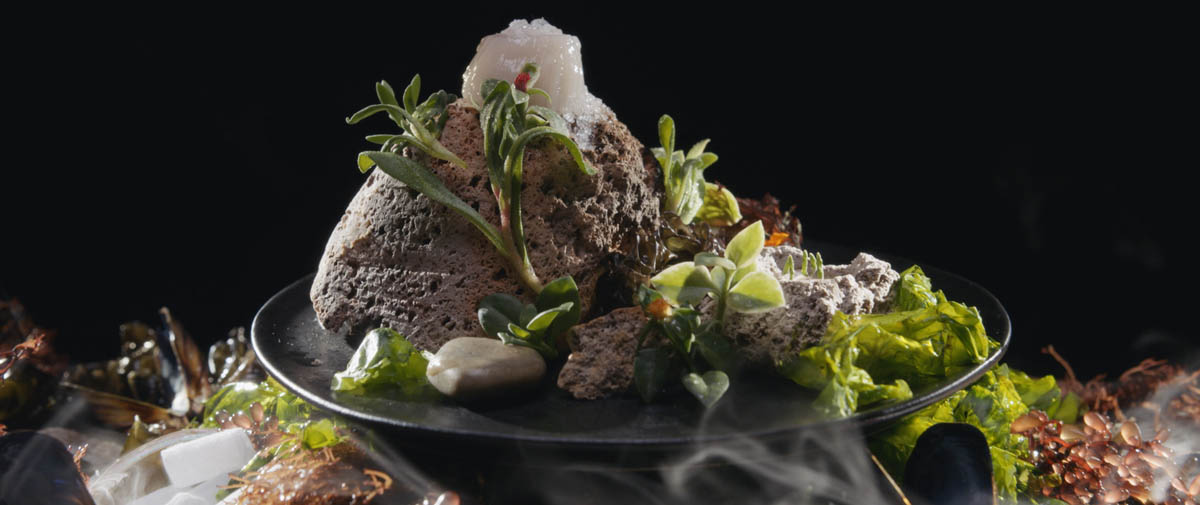
The biggest takeaway from that experience was the experience of their process, of being there from dailies to the end of the mix. That's being there throughout that scene, every single process going through every single screening, every single massive amount of changes, and then music, sound, et cetera, and then all the way to the very, very end.
That's the takeaway that resonates that you really get. It's almost not that tight. She's very intuitive and she's a very, very strong editor and reactive.
What about the soft skills? What about the political skills? The collaboration skills?The biggest takeaway was the experience of their process, of being there from dailies to the end of the mix. That was being there through every single screening, all the massive amount of changes, and then music, sound, et cetera, all the way to the very end.
That's the takeaway that resonates, that I absorbed. A privledged view into their process. Thelma is very intuitive and she's a very strong editor and reactive. She and Marty have a legendary collaboration and I got a lot out of pure observation.
As far as collaborating with directors, I work with a lot of different directors and I find that very stimulating. I like being in a new situation, a “What's this going be?” kinda thing. Then, discovering and finding my way. I'm pretty good with extreme personalities actually. There’s plenty of them [laughs].
I was thinking of the politics of when to say, “Oh my gosh, this scene is a disaster” and when to say, “Maybe I shouldn't say that.”I'll say whatever I think or feel without hesitation. There's always a fine line of figuring out when the right time to say certain things are. Those are important life skills that go beyond the editing room.
Exactly. One of the things I did not know about you was that you curate Martin Scorsese's film collection.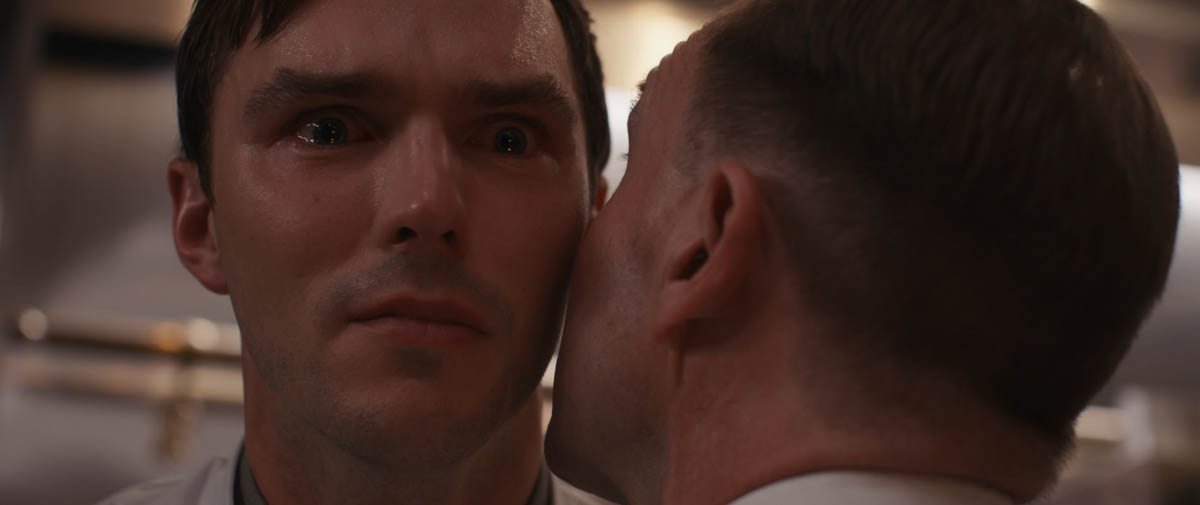
I worked on his archive. That was in 1986 for about six months because, let's face it, with those kinds of archival jobs, you could do them for the rest of your life. I had no intention of doing any such thing [laughs], just wiping the dust off myself after 80 years. To be honest with you, it was a great experience working with Marty and Thelma, but they saw you as one thing. There is little movement in that world and I knew I had to move on quickly. I left to edit a short and that short helped me get Metropolitan, and so on, and so on and so on. But the beauty of that was I had access to Scorsese's collection. I was exposed to films that I really love. I would take movies home every night. There was a library borrowing system. It was amazing. It was a big eye-opener for certain things like all of the Powell and Pressburger films, "I Know Where I'm Going," being a favorite. At the time, Thelma was married to Michael Powell. He would come and visit and we had interesting screenings.
He was a lovely guy, a very charming, very interesting person and a master filmmaker. Some favorites from Marty's collection were Italian comedies of the ‘50s into the early ‘60s. I'll just rattle a few of 'em off: Fellini’s I Vitelloni and The White Sheik, Dino Risi’s Il Sorpasso, Alberto Lattuada’s Mafioso, Pietro Germi's Divorce, Italian Style, Marco Ferreri’s The Ape Woman, Mario Monicelli's Big Deal on Madonna Street and Risate di Gioia. Just amazingly great films. I learned a lot from being exposed to them, about subtlety of humor and character and eccentricity and rhythm and the dynamics between characters. Because you asked about what has affected me in terms of films of the past, there's the work of Cécile Decugis, the French editor who did Breathless and Les Mistones. Also, My Night at Maud’s, the Eric Rohmer film. That's a film that I found affected me, because it's extremely spare and reduced and very clear in its editorial choices.
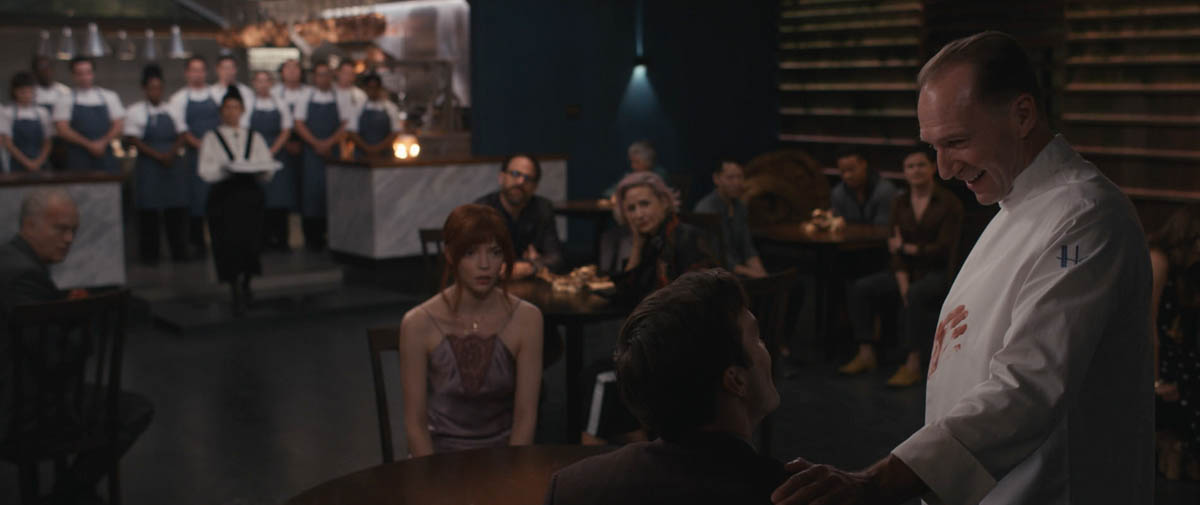
It's definitely something I learned from. I watched that and thought, “This is doing the right thing. Editorially, you're in the right place at the right time for the temperature and the psychology and the humor and the pathos. Everything’s in the right place.” I think that helped me with Metropolitan, which was a comedy of manners and also had a lot of heart to it. Finding those subtleties was helpful. I was very influenced by the early British New Wave, Tony Richardson's films that were edited by Anthony Gibbs like The Loneliness of The Long Distance Runner. He also edited the John Lester film, The Knack… and How to Get It, which is really great. I could go on and on and on about films that influenced me.
One very, very clear thing, a film that was very important to me, a film foundational to The Menu, is the Buñuel film, The Exterminating Angel. I saw it in 1975, when we went to revival houses to see movies. There were no VCRs even. There was nothing. You had to go to a movie theater. Remarkably, It was in the minds of the writers Seth Reiss and Will Tracy when they wrote it and it was also very important to Mark Mylod, the director. There is a direct, visual reference to it in The Menu, the image of the angel on the silver, secret door. I'd gone to see Bunuel's Viridiana and The Exterminating Angel was playing with it in a double feature. It was just this key, significant thing. I was intrigued and disarmed. It has one of the most interesting edits in history. Are you aware of the film?
No. I've got the Criterion Channel. I’m gonna watch it today.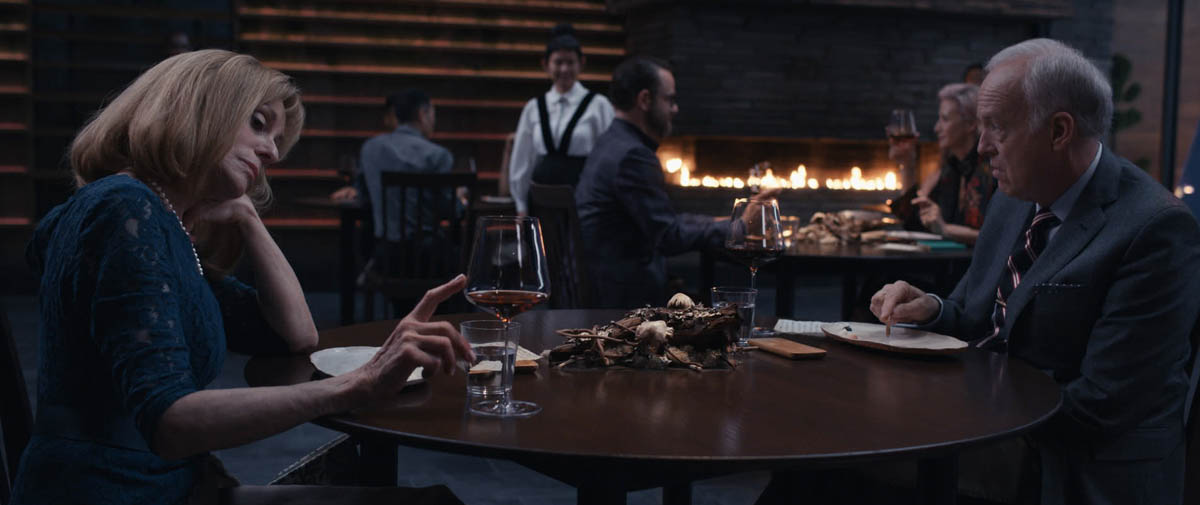
There is a repeated shot within it, like a completely repeated shot. It is so interesting and so effective and it's the kind of thing that I always think, “Can I ever do that? That's a really hard thing to do and make it work.” The thing about The Exterminating Angel is it's an enigmatic piece on class differences and privilege and the effect on The Menu being the inertia of the privileged, believing that they're above judgment and punishment, peeling away layers of rot. In E.A. a wealthy couple and their guests are arriving from the opera to their home for dinner, while the entire staff of servants are leaving for no explained reason, just that something feels wrong to them and it's intuitive. The most servile of the group of servants stays with them. Then, the whole dinner party retreats to the parlor for coffee and music. There's a pianist that plays. At the end of the evening, they inextricably cannot leave. No one says why and they are self-trapped for months in this space. They can't leave it.
The genius of this film is on a level beyond sense and the metaphors are endless, like believing in a political system no matter what, not questioning or challenging authority. When we strip away privilege, everyone is vulnerable. It's endless what you can derive from it. What I think is interesting now about The Menu is that it is stirring up a lot of people's thoughts and spawning theories. I think it's a pretty rich film and I'm very proud of it.
I want to touch base on this one idea that you just pointed out, which was you saw this film that was very affecting to you almost 40 years ago.Oh yeah. The interesting thing to reflect on was that it was made in 1962 and I only saw it 13 years later. 13 years ago now is, what, 2011?
Right? It's crazy.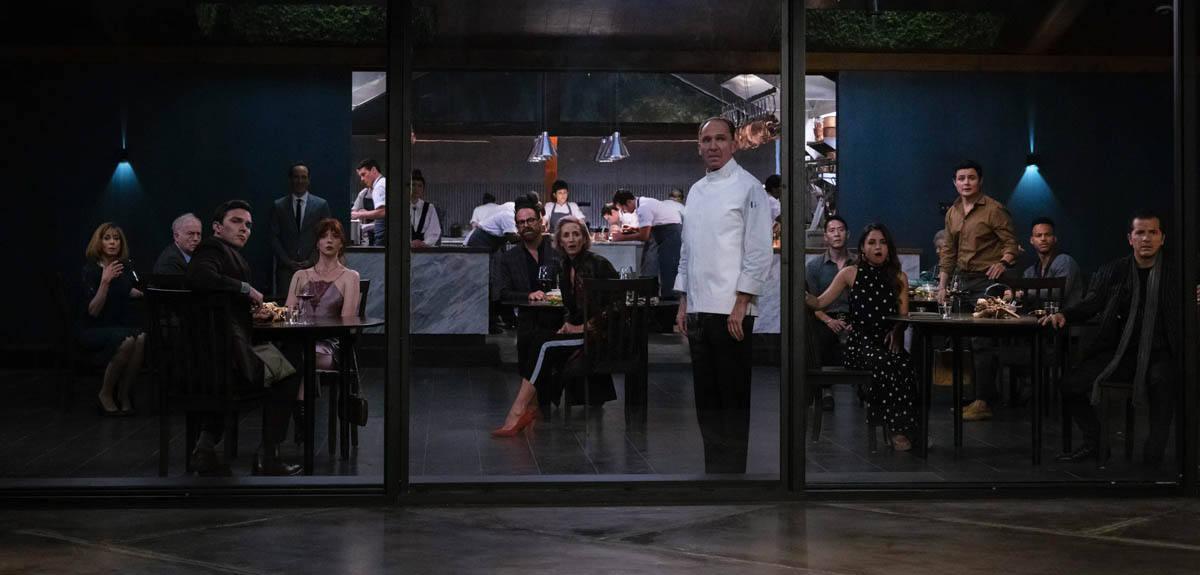
The 21st century is just going like that. (Snaps fingers).
When you thought, “Oh, I’m gonna work on this film, by the way…”When I read the script of The Menu, I read into the lines and I felt it.
Did you re-watch the film?I watch it maybe every two years.
Wow.If it's ever on a big screen, I'm there. I saw it in London on a big screen 9 years ago. Also, it's been adapted into an opera.
Any great films that should be studied for editing? Because of Thelma: no choosing Raging Bull.I think I just mentioned about 20 [laughs]. The ones that I mentioned, I'd suggest everyone watch.
Chris, thank you so much for your time.Thanks, Steve. It’s always a pleasure. Thank you.T

